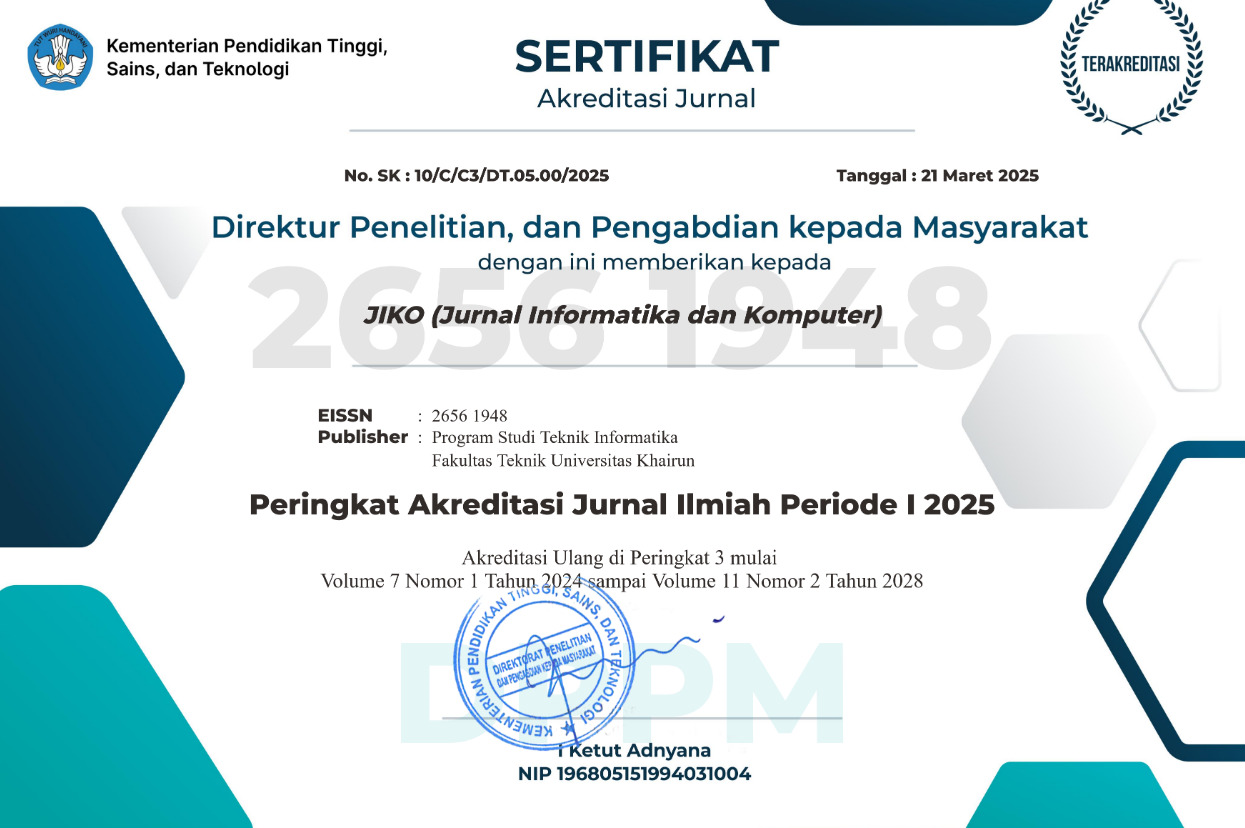CLASSIFICATION OF JAVANESE NGLEGENA SCRIPT USING COMPLEXVALUED NEURAL NETWORK
Abstract
Full Text:
PDFReferences
S. C. A. Pradhana, U. N. Wisesty, and F. Sthevanie, “Pengenalan Aksara Jawa dengan Menggunakan Metode Convolutional Neural Network,†e-Proceeding Eng., vol. 7, no. 1, pp. 2558–2567, 2020.
M. A. Rasyidi, T. Bariyah, Y. I. Riskajaya, and A. D. Septyani, “Classification of handwritten javanese script using random forest algorithm,†Bull. Electr. Eng. Informatics, vol. 10, no. 3, pp. 1308–1315, 2021, doi: 10.11591/eei.v10i3.3036.
T. Rahardjo, N. Degeng, and Y. Soepriyanto, “Pengembangan Multimedia Interaktif Mobile Learning Berbasis Anrdroid Aksara Jawa Kelas X Smk Negeri 5 Malang,†J. Kaji. Teknol. Pendidik., vol. 2, no. 3, pp. 195–202, 2019, doi: 10.17977/um038v2i32019p195.
I. G. S. M. Diyasa, A. Fauzi, M. Idhom, and A. Setiawan, “Multi-face Recognition for the Detection of Prisoners in Jail using a Modified Cascade Classifier and CNN,†J. Phys. Conf. Ser., vol. 1844, no. 1, 2021, doi: 10.1088/1742-6596/1844/1/012005.
F. M. Adenansyah, “Rancang Bangun Game Edukasi Belajar Aksara dan Tata Krama Bahasa Jawa untuk SD Kelas 4 Berbasis Android,†J. Manaj. Inform., vol. 10, no. 9, pp. 1–9, 2019.
C. Dian Ikawati Susilo and D. Indira, “Filosofi Hanacaraka Bahasa Jawa Suatu Kajian Etnolinguistik,†Kongr. Int. Masy. Linguist. Indones., pp. 30–34, 2022, doi: 10.51817/kimli.vi.17.
D. Fakhruddin, A. Sachari, and N. Haswanto, “Pengembangan Desain Informasi dan Pembelajaran Aksara Jawa melalui Media Website,†ANDHARUPA J. Desain Komun. Vis. Multimed., vol. 5, no. 01, pp. 1–23, 2019, doi: 10.33633/andharupa.v5i01.1990.
D. A. Prasetya, P. T. Nguyen, R. Faizullin, I. Iswanto, and E. F. Armay, “Resolving the shortest path problem using the haversine algorithm,†J. Crit. Rev., vol. 7, no. 1, pp. 62–64, 2020, doi: 10.22159/jcr.07.01.11.
R. Trabelsi, I. Jabri, F. Melgani, F. Smach, N. Conci, and A. Bouallegue, “Indoor object recognition in RGBD images with complex-valued neural networks for visually-impaired people,†Neurocomputing, vol. 330, pp. 94–103, 2019, doi: 10.1016/j.neucom.2018.11.032.
R. Novaliandy and A. R. Widiarti, “Klasifikasi Aksara Jawa Cetak Menggunakan Jaringan Syaraf Tiruan Backpropagation,†Pros. Semin. Nas. Ilmu …, pp. 307–312, 2022, [Online]. Available: https://mail.puterabatam.com/index.php/prosiding/article/view/5351
I. S. Hanindria and H. Hendry, “Pengklasifikasian Aksara Jawa Metode Convolutional Neural Network,†JATISI (Jurnal Tek. Inform. dan Sist. Informasi), vol. 9, no. 3, pp. 2727–2737, 2022, [Online]. Available: https://jurnal.mdp.ac.id/index.php/jatisi/article/view/2177
J. A. Barrachina, C. Ren, G. Vieillard, C. Morisseau, and J.-P. Ovarlez, “Theory and Implementation of Complex-Valued Neural Networks,†no. June, 2023, [Online]. Available: http://arxiv.org/abs/2302.08286
J. Krzyston, R. Bhattacharjea, and A. Stark, “Complex-valued convolutions for modulation recognition using deep learning,†2020 IEEE Int. Conf. Commun. Work. ICC Work. 2020 - Proc., 2020, doi: 10.1109/ICCWorkshops49005.2020.9145469.
T. Muhamad Hafiez, D. Iskandar, A. Wiranata S.K, and R. Fitri Boangmanalu, “Optimasi Klasifikasi Gambar Varietas Jenis Tomat dengan Data Augmentation dan Convolutional Neural Network,†Smart Comp Jurnalnya Orang Pint. Komput., vol. 11, no. 2, pp. 175–186, 2022, doi: 10.30591/smartcomp.v11i2.3524.
A. Muhaimin, D. D. Prastyo, and H. H. S. Lu, “Forecasting with recurrent neural network in intermittent demand data,†Proc. Conflu. 2021 11th Int. Conf. Cloud Comput. Data Sci. Eng., pp. 802–809, 2021, doi: 10.1109/Confluence51648.2021.9376880.
R. A. Pengestu, B. Rahmat, and F. T. Anggraeni, “Implementasi algoritma CNN untuk klasifikasi citra lahan dan perhitungan luas,†J. Inform. dan Sist. Inf., vol. 1, no. 1, pp. 166–174, 2020.
DOI: https://doi.org/10.33387/jiko.v7i1.7808
Refbacks
- There are currently no refbacks.











